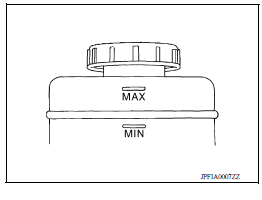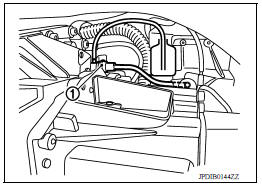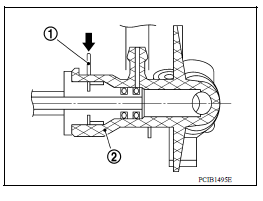Nissan Versa (N17): Clutch fluid
CLUTCH FLUID : Inspection
FLUID LEAKAGE
- Check clutch line for cracks, deterioration or other damage. Replace any damaged parts.
- Check for fluid leakage by fully depressing clutch pedal while engine is running.
CAUTION: If leaks occur around connections, reinstall the lines or replace damaged parts, if necessary.
FLUID LEVEL
- Check that the fluid level in the reservoir tank is within the specified range, between the MAX and MIN lines as shown.
- Visually check for any clutch fluid leaks around the reservoir tank.
- Check the clutch system for any leaks if the fluid level is extremely low (lower than MIN).

CLUTCH FLUID : Draining
CAUTION: Do not spill clutch fluid onto painted surfaces. If fluid spills, wipe up immediately and wash the affected area with water.
1. Connect a transparent vinyl hose to air bleeder of bleeding connector (1).

2. Press the lock pin (1) into the bleeding connector (2), and maintain the position.

3. Slide clutch tube (1) for the specified distance (A) in the direction
of the arrow (  ) as shown.
) as shown.
(2) : Bleeding connector
Dimension (A) : 5 mm (0.20 in)
CAUTION: Do not allow the clutch tube to disconnect from the bleeding connector.

4. Depress clutch pedal to gradually discharge clutch fluid.
CAUTION: Clutch tube is under hydraulic pressure; do not allow the clutch tube to disconnect from the bleeding connector.
CLUTCH FLUID : Refilling
CAUTION: Do not spill clutch fluid onto painted surfaces. If fluid spills, wipe up immediately and wash the affected area with water.
1. Check that there is no foreign material in reservoir tank and then fill with new clutch fluid.
CAUTION: Do not reuse drained clutch fluid.
2. Connect a transparent vinyl hose to air bleeder of bleeding connector (1).

3. Press the lock pin (1) into the bleeding connector (2), and maintain the position.

4. Slide clutch tube (1) for the specified distance (A) in the direction
of the arrow (  ) as shown.
) as shown.
(2) : Bleeding connector
Dimension (A) : 5 mm (0.20 in)

5. Slowly depress clutch pedal to the full stroke position and then release the pedal.
CAUTION: Clutch tube is under hydraulic pressure; do not allow the clutch tube to disconnect from the bleeding connector.
6. Repeat step 5 at intervals of 2 or 3 seconds until new clutch fluid is discharged.
CAUTION: Monitor clutch fluid level in reservoir tank so as not to empty the tank.
7. Return clutch tube and lock pin in their original positions while clutch pedal is depressed.
8. Perform the air bleeding. Refer to CL "Air Bleeding".
 A/T Fluid
A/T Fluid
A/T FLUID : Inspection FLUID LEAKAGE Check transaxle surrounding area (oil seal and plug etc.)for fluid leakage. If anything is found, repair or replace damaged parts and adjust A/ T fluid ...
M/T Oil
M/T OIL : Inspection OIL LEAKAGE Make sure that gear oil is not leaking from transaxle or around it. OIL LEVEL 1. Remove filler plug (1) and gasket from transaxle case. 2. Check the oil level f ...
Other materials:
Power outlets
Instrument panel
Console (if so equipped)
The power outlets are for powering electrical
accessories such as cellular telephones. The
outlets are rated at 12 volt, 120W (10A) maximum.
CAUTION
The outlet and plug may be hot during
or immediately after use.
Only certain power outlets ...
Increasing fuel economy
Keep your engine tuned up.
Follow the recommended scheduled maintenance.
Keep the tires inflated to the correct pressure.
Low tire pressure increases tire wear
and lowers fuel economy.
Keep the wheels in correct alignment. Improper
alignment increases tire wear and
lowers fuel eco ...
Categories
- Manuals Home
- Nissan Versa Owners Manual
- Nissan Versa Service Manual
- Video Guides
- Questions & Answers
- External Resources
- Latest Updates
- Most Popular
- Sitemap
- Search the site
- Privacy Policy
- Contact Us
0.0065
